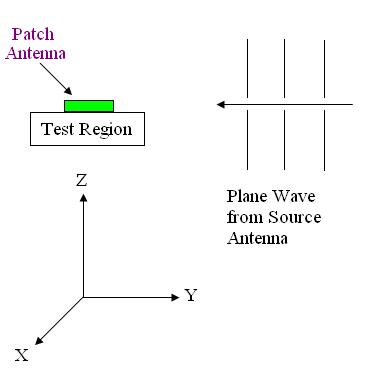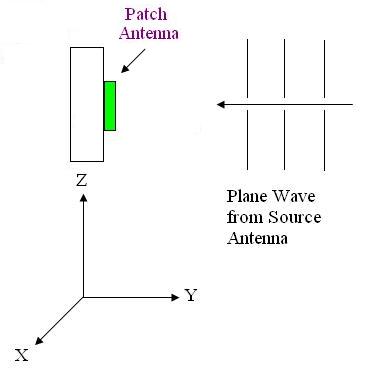Measuring Radiation Pattern and an Antenna's Gain
|
Now that we have our measurement equipment and an antenna range, we can perform some antenna measurements. We will use the source antenna to illuminate the antenna under test with a plane wave from a specific direction. The polarization and antenna gain (for the fields radiated toward the test antenna) of the source antenna should be known.
Due to reciprocity, the radiation pattern from the test antenna is the same for both the receive and transmit modes. Consequently, we can measure the radiation pattern in the receive or transmit mode for the test antenna. We will describe the receive case for the antenna under test.
The test antenna is rotated using the test antenna's positioning system. The received power is recorded at each position. In this manner, the magnitude of the radiation pattern of the test antenna can be determined. We will discuss phase measurements and polarization measurements later.
The coordinate system of choice for the radiation pattern is spherical coordinates.
Measurement ExampleAn example should make the process reasonably clear. Suppose the radiation pattern of a microstrip antenna is to be obtained. As is usual, lets let the direction the patch faces ('normal' to the surface of the patch) be towards the z-axis. Suppose the source antenna illuminates the test antenna from +y-direction, as shown in Figure 1.
 Figure 1. A patch antenna oriented towards the z-axis with a Source illumination from the +y-direction.
In Figure 1, the received power for this case represents the power from the angle:
 Figure 2. A patch antenna rotated to measure the radiation power at normal incidence.
In Figure 2, the positioning system rotating the antenna such that it faces the source of illumination. In this case,
the received power comes from direction
It must be stressed that the resulting radiation pattern is correct for a given polarization of the source antenna. For instance, if the source is horizontally polarized (see polarization of plane waves), and the test antenna is vertically polarized, the resulting radiation pattern will be zero everywhere. Hence, the radiation patterns are sometimes classified as H-pol (horizontal polarization) or V-pol (vertical polarization). See also cross-polarization.
In addition, the radiation pattern is a function of frequency. As a result, the measured radiation pattern is only valid at the frequency the source antenna is transmitting at. To obtain broadband measurements, the frequency transmitted must be varied to obtain this information. |
Antenna Theory (Home)
 . We record this power, change the position
and record again. Recall that we only rotate the test antenna, hence it is at the same distance from the source antenna.
The source power again comes from the same direction. Suppose we want to measure the radiation pattern
normal to the patch's surface (straight above the patch). Then the measurement would look as shown in Figure 2.
. We record this power, change the position
and record again. Recall that we only rotate the test antenna, hence it is at the same distance from the source antenna.
The source power again comes from the same direction. Suppose we want to measure the radiation pattern
normal to the patch's surface (straight above the patch). Then the measurement would look as shown in Figure 2. . So by rotating the antenna,
we can obtain "cuts" of the radiation pattern - for instance the
. So by rotating the antenna,
we can obtain "cuts" of the radiation pattern - for instance the
 =0 and
=0 and
 is allowed to
vary from 0 to 360 degrees. Another common radiation pattern cut (a cut is a 2d 'slice' of a 3d radiation pattern)
is when
is allowed to
vary from 0 to 360 degrees. Another common radiation pattern cut (a cut is a 2d 'slice' of a 3d radiation pattern)
is when